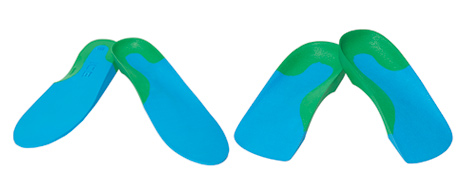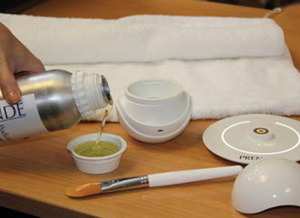| Plantar Fasciitis (PF) is a degenerative syndrome of the plantar fascia resulting from repeated trauma at its origin at the calcaneus1.
It is reported to be the most common cause of inferior heel pain in adults2. Plantar fasciitis is also known as painful heel syndrome, heel spur syndrome3, runner’s heel, policemen’s heel, subcalcaneal pain, calcaneodynia and calcancal periostitis. Treating the causative factors of plantar fasciitis is key to designing a treatment for your patient.Using the point of pain test will indicate if the pain is Lateral, Central or Medial.Valmassey refers to plantar fasciitis as affecting both pes planus and pes cavus foot types4 with opinion being that different pain regions may be suffered depending upon the foot structure (watch video).Generally speaking the following often applies: • Lateral Heel Pain is often associated with an uncorrected forefoot valgus and pes cavus foot type. • Central Heel Pain often indicates a forefoot valgus is present, in addition to rearfoot pronation. • Medial Heel Pain generally indicates the patient will exhibit excessive rearfoot pronation. |
 |
Point of Pain TEST
In each case, treatment will involve prescribing an orthotic device to control rearfoot pronation and provide biomechanical correction. In the cases of Central and Medial pain, a heel deflection (referred to as a ‘horseshoe deflection’) in the orthotic can also assist by relieving pressure on the attachment. Low Dye Strapping can be used to provide short term pain relief, as it mimics the support and control offered by an orthotic device.
Shockwave therapy has also been used to some effect in breaking up scar tissue. Anti-inflammatory medications, massage and surgery are generally less successful in the long term treatment of Plantar Fasciitis.
TREATMENT SOLUTION: ICB MOULDING ORTHOTICS
ICB Sports Orthotics have an intrinsic 5° rearfoot varus angle to assist in controlling rearfoot pronation, and a horse shoe deflection making them ideal for treatment of Plantar Fasciitis.
References:
1. Cornwall MW. McPoil TG., Plantar fasciitis : Etiology and Treatment. Orthopaedic Sports Physiotherapy (1999);29:756-76
2. Singh D. Angel J. Becky G. Trevino SG.,Fortnightly review. Plantar fasciitis. BMJ (1997):315:172-17.S.
3. Lemont H, Ammiiati KM, Usen N. Plantar Fasciitis: A Degenerative Process (fasciosis)
Without Inflammation. American Journal Podiatric Medicine Assoc (2003); 93:234-237
4. R.L. Valmassey, Clinical Biomechanics of the Lower Extremities. (1996) p76


















